The Canned “RTD” Cocktail Boom is a Worst Case Scenario for Tiki Drinks
Photos via Unsplash, Wine Dharma, Sunny Wang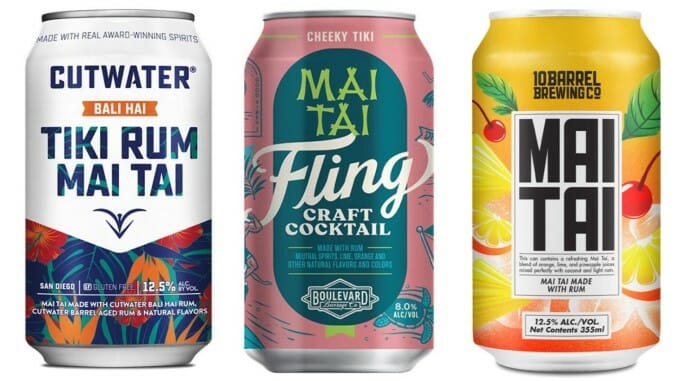
There’s no denying that from both a business and drinking culture point of view, one of the biggest stories of the pandemic era has been the meteoric rise of ready-to-drink (RTD) cocktails. Perhaps initially in response to scenarios that saw Americans trapped in their homes and unable to hit the local bar scene, but eventually gaining strength and sentience all its own, the RTD boom has leaned on convenience as its primary feature, promising consumers the ability to take their favorite, pre-mixed cocktails wherever they want. Spirits-based RTDs in particular (as opposed to flavored malt beverages that mislead consumers into thinking they contain spirits, more on that later) have seen meteoric growth, with spirit-based seltzers and RTD cocktails growing 60% or more in chain retail stores in 2021. These are the boom times for canned cocktails, in other words, and all the biggest players in the alcohol industry have scrambled to get a piece of the action.
These facts, in and of themselves, aren’t necessarily something we think is bad news for drinkers who appreciate good cocktails. I’ve personally tasted and reviewed a fair number of these drinks for Paste, and there are some quality examples on the market—faithful canned takes on simple, classic cocktails such as the old fashioned, margarita or Manhattan. A company such as Golden Rule Spirits particularly impresses in the way they deliver no more and no less than what is promised: A legitimate old fashioned, at a strength (79 proof!) that assures the drinker there’s nothing at all included beyond whiskey, sugar and bitters. This is a canned cocktail as it ought to be, the closest thing one can get to just bottling a batch from the bar.
There is one area of the RTD market, though, that stands out as deeply problematic and inherently unsuited to being contained in a can in the first place. I’m talking about classic, rum-based tiki/tropical cocktails, which inherently demand a level of preparation and complexity that is outside the realm of what RTD drink makers want to offer. They do, however, seem to recognize the value of a term like “mai tai,” and what we’ve seen in response is a new wave of abominable bastardizations of classic tiki drinks. Whereas it’s not difficult to offer a legitimate canned version of a gin & tonic or an old fashioned, classic tiki cocktails are getting absolutely abused in this emerging market, and it threatens to both devalue the image of the drinks themselves and turn an entire new generation off the glory of well-made tiki drinks.
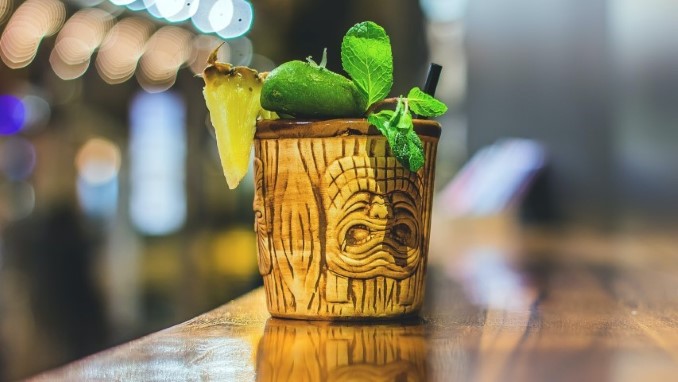 An actual mai tai, in its natural habitat.
An actual mai tai, in its natural habitat.
Why Canned Tiki Cocktails are Being Butchered
The hurdles standing in the way of a great canned version of a classic tiki cocktail such as the mai tai are numerous, so let’s go through them here. In short, these drinks are generally too complex, too strong, too exotic and too situational for RTD companies to ultimately offer an accurate, premixed version. Instead, they respond by dumbing down the cocktail recipes, offering insipid, weak versions that fit in better alongside more basic mixed drinks. The ultimate effect is like a return to the absolute nadir of the tiki cocktail, which occurred in the 1970s-1990s as traditional recipes were abandoned and most drinks simply became colorful, horrendously sweetened disasters. In more specific detail:
— Most tiki cocktails are defined by complexity, and complexity in tiki drinks often comes from a large number of ingredients, some of which require a lot of effort to either procure or make. Well-made tiki cocktails often feature multiple kinds of fresh fruit juice, various syrups being used for sweetness or to add spices, blends of rums/other spirits, and additional liqueurs or mixers. RTD cocktail makers, on the other hand, want the production of these products to be as simple as they possibly can be, and that is almost universally going to result in worse cocktails.
— Most RTD companies would prefer to package these drinks in 12 oz cans, which are far too large for any kind of full-strength tiki cocktail, to the point that it would be irresponsible to sell genuine tiki cocktails in such a large volume. You can’t, for instance, be selling people 12 oz cans full of a traditionally made zombie cocktail, because the consumer will not understand that the can contains many standard drinks worth of alcohol. Some of the better RTD companies package their product in much smaller cans of around 100 ml, but these more niche, authentic products are rarely category leaders because with authenticity comes a higher price tag.
— Most companies making RTD cocktails have zero respect for the history or authenticity of these tiki cocktails, because they assume (probably correctly) that the average American consumer will never know that they’re being fed a fake. In the eyes of a company making canned cocktails, a consumer can’t be trusted to understand what something like “orgeat” is, and their unfamiliarity might actually make those consumers less likely to try the cocktail if they see an ingredient they don’t recognize. And yet, you literally can’t make a legitimate mai tai without orgeat, but that hasn’t stopped most of these companies from doing exactly that.
An RTD Case Study: Terrible Canned Mai Tais
The mai tai is perhaps the most iconic and indispensable tiki cocktail of all time, dating all the way back to its 1944 invention by famed tiki innovator and business tycoon Victor J. Bergeron, aka Trader Vic. Since its birth in California, the mai tai has become the drink that most encapsulates the expectations of tiki cocktails as a style of drink, and it’s one of the few cocktails that you can reasonably expect to find on the menu at pretty much any “tiki bar.” It’s also become undoubtedly the most frequently bastardized tiki cocktail in the world of RTD drinks.
A classic, traditional mai tai consists of the following ingredients: A blend of rum, along with lime juice, orange curacao, simple syrup and orgeat. It’s actually relatively simple as far as tiki cocktails are concerned, lacking the wider plethora of fruit juices and liqueurs that are found in even more complex drinks, such as the zombie. But that doesn’t stop most RTD cocktail makers from ignoring the classic recipe, instead substituting ingredients that make the drink more friendly, fruity, sweet and watered down. Here are a few examples:

Cutwater’s product is likely one of the biggest canned mai tais on the market today, and the drink in the can has almost nothing in common with an actual mai tai. The AB InBev-owned company says its 12 oz cans contain “Cutwater Barrel Aged Rum, Bali Tai Tiki Gold Rum, pineapple, coconut and citrus,” without even going on the record as to what that “citrus” might be. It weighs in at 12.5% ABV.
Suffice to say, there’s a lot wrong here. The rum blend actually isn’t as bad as some, but pineapple is a decidedly non-traditional mai tai ingredient that only began being added with regularity to inferior versions of the drink that proliferated as tiki bars hit their low point in the back half of the 1900s. Coconut, on the other hand, isn’t present in any version of the mai tai, and has seemingly just been added here out of the misplaced notion that “coconut = tiki.” The orgeat, meanwhile, is missing, and that almond syrup is the single most important flavor in a classic mai tai, after the rum. Given that, and the low ABV, all you’re getting here is a watered-down rum punch of some kind—not a mai tai in any way, shape or form.
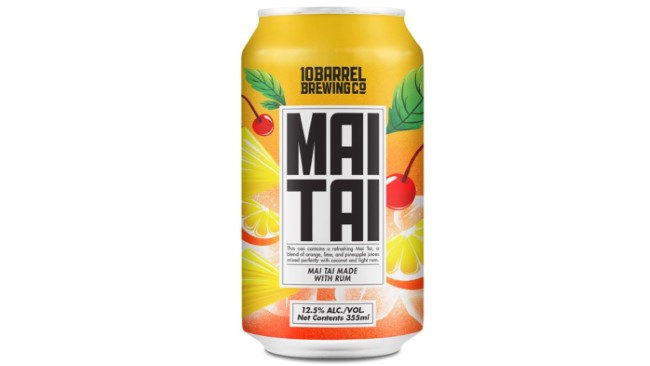
This mai tai is so far off base that the company doesn’t even list its ingredients on the website, and only by zooming in on the can itself can you see that it’s made with “a blend of orange, lime and pineapple juices mixed perfectly with coconut and light rum.” It too weighs in at 12.5% ABV, in a 12 oz can.
Obviously, this has some of the same sins. Orange juice is not orange curacao, folks, and a bitter, dry orange peel liqueur does not taste like orange juice any more than Luxardo maraschino liqueur tastes like cherry juice. The rums here are even more objectionable, as most mai tais are made primarily with aged rum, and coconut rum is nowhere to be found. This feels like a drink made by simply reaching into the well behind a bar and mixing whatever you find there.
Note, it should come as no surprise that AB InBev owns both Cutwater and 10 Barrel, and that both of these mai tais are horrendous. A multinational conglomerate has no qualms at all about bastardizing classic tiki cocktails in exactly the same way that they do to classic beer styles and other corners of the cocktail world.

With that said, even if the likes of AB InBev are majorly guilty of perverting these iconic drinks, even some craft brewers (as defined by the Brewers Association) are guilty of the same offenses. Look no further than Boulevard Brewing Co.’s Fling Craft Cocktail line, which has an absolutely heinous recipe described as the following: “Made with rum, neutral spirits, lime, orange and other natural flavors and colors.”
Good god, folks. This merely 8% ABV drink is apparently bolstered by neutral grain spirits, which means they didn’t even use solely rum—this is more like a mix of rum and Everclear, then supported by “natural flavors.” The description lacks any reference to orgeat, while the additional description cites “almond and spice” notes, suggesting that instead of just using orgeat, the company has instead used almond flavoring or extract. To say that this whole concept, then present at an extremely weak 8% ABV, is an abomination to legitimate tiki cocktails is just scratching the surface of what could be said about it. A cocktail geek can only view something like this as a travesty.
Juneshine Tropical Rum Mai Tai
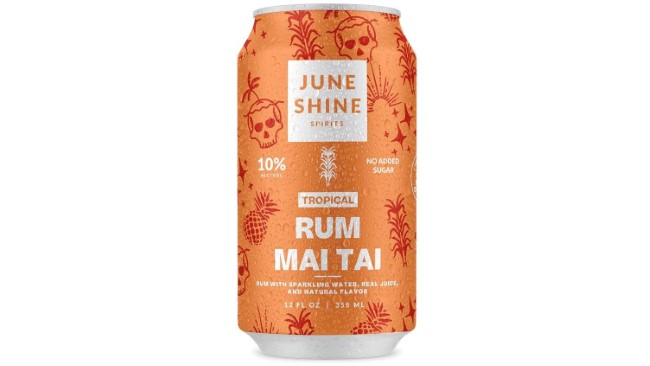
Smaller, independent RTD cocktail makers are often making the better examples of these drinks, but there are butchered mai tais among these companies as well. This one from Juneshine grabs every random ingredient possible from the well, including: “spiced rum, white rum, sparkling water, orange, cherry, lime, pineapple and coconut.” Some of these incorrect ingredients are already familiar by now, but there’s some new oddities—in what sense are they adding “cherry,” exactly? And why include “sparkling water” as a feature? To make the extremely watered down 10% ABV sound more palatable? The company then goes on to note that the drink is made with “no added sugar.”
This is where we run into another problem of the ethos of RTD cocktails being incompatible with the ethos of tiki drinks—almost ALL of these drinks contain at least some form of “added sugar” to be authentic, in the form of flavored or spiced syrups. If you take away the modest addition of sweetness in a classic recipe like the mai tai, you render these drinks as overly acidic, spirit-forward messes. It is sweetness that gives life to the tropical flavors, especially fruit such as citrus. Without at least a modicum of sweetness, the drinks turn boozy, flat and hollow all at once.
This act strips away the carefully constructed balance of a drink like the mai tai, in the name of trying to absorb the cocktail into 21st century wellness and health culture. It’s ironic, because traditional tiki cocktails are about as far from “wellness” culture as one can get—they are decadent, luxurious and exotic, promising the allure of escape to far-off locales where you would be visiting on a bacchanal vacation rather than an exercise training montage. Trying to make tiki cocktails seem “better for you” undercuts the entire soul of the style, in an attempt to cram them into the mold of the 21st century, mommy blogger-friendly outline.
It should be no surprise that the same company also makes hard kombucha, and then tries to call that drink a “painkiller” (another classic rum cocktail).
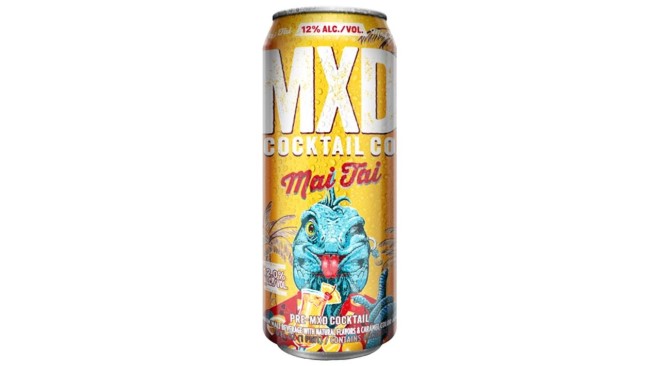
But wait, it still gets worse. There are even canned items on the shelf masquerading as a mai tai that don’t even contain any rum. Instead, MXD Mai Tai (in a 16 oz can!) is made with alcohol from malt fermentation, essentially making this a 12% ABV hard seltzer, but one that is going out of its way to attempt to trick the consumer into thinking it contains rum. The lawsuit-worthy description says it “combines the flavors of Caribbean rum, pineapple, orange and lime to deliver a classic Mai Tai cocktail that would be welcome in any tiki bar.” That’s odd, because if you ask us, it’s hard to “combine the flavors of Caribbean rum” with anything when YOUR PRODUCT CONTAINS ZERO RUM BY YOUR OWN ADMISSION. What a bunch of charlatans.
Are there some legitimate canned mai tais that do exist on the market? Yes there are, and I’ll highlight two below, but they are few and far between. The big problem is that the imposters are far cheaper to make, and they subsequently dominate the market—these are the companies that have been accounting for the massive growth of the RTD segment. AB InBev’s Cutwater Spirits, for example, grew 185% in 2021 while making a lousy, fake mai tai. And if that’s the reward for faking it, why would you bother making the real thing when most consumers don’t know any better?
With that said, some of the most egregious examples actually may leave themselves open to litigation for misleading consumers, as we suggest above. In 2021, rapper Travis Scott’s AB InBev brand of hard seltzer, Cacti, launched as one of the hottest new seltzer brands of the year, but it was ultimately caught up in a class action lawsuit that alleged it misled consumers into assuming the “agave” it boasted of featuring was in the form of agave spirits, aka tequila. Following cooling sales and the stigma attached to Scott after the Astroworld festival disaster, AB InBev discontinued the brand at the end of the year. One could easily imagine similar lawsuits being leveled at a canned mai tai that contains no rum, or a canned ranch water that contains no tequila, or a canned Long Drink that contains no gin. It’s all part of a broader story on how hard seltzers are being used to sell misleading drinks to fans of spirits and legitimate cocktails/mixed drinks.
A Few Legitimate Canned Tiki Drinks
For the record, it isn’t that hard to find a decent canned daiquiri, though the three-ingredient daiquiri (rum, lime, sugar) isn’t traditionally considered a “tiki drink” per se. Finding real canned mai tais, on the other hand, is much more onerous, but there are indeed a few of them out there, and they deserve some recognition here. Unfortunately, these companies are far smaller, and subsequently less likely to come up on the first page of a Google search, even when using terms like “canned mai tai.”

This attractive can from Proof Cocktail Co. is 250 ml, a more reasonable size than the 12 oz ones for a drink that is meant to be poured over a bunch of crushed ice. Its ingredients are listed as the following: “The perfect blend of West Indies Silver Rum, American bourbon barrel aged rum, curaçao and organic almond Orgeat, with freshly squeezed lime, orange juices and just a hint of pomegranate grenadine.” The grenadine isn’t completely traditional, but it’s not outside the realm of normalcy for the mai tai, either. Plus, it sounds like legitimate pomegranate grenadine, rather than the artificially colored and flavored corn syrup in your Shirley Temple.
All in all, this is far more authentic than any of the canned cocktails above, and it’s also present at a much more robust 23% ABV, almost three times stronger than Boulevard’s Fling Craft Cocktail Mai Tai. This all suggests a drink that will actually bring the assertiveness of flavor that tiki cocktails are known for.
Post Meridiem Spirits 1944 Mai Tai
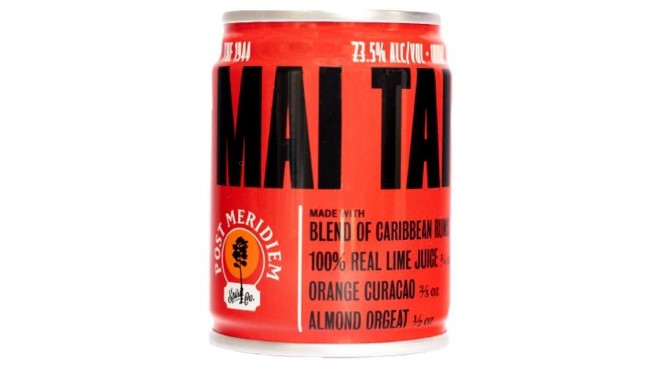
This Atlanta-based company has rendered some authentic and impressive renditions of a few tiki/tropical cocktails, including this mai tai. Rather incredibly, for the RTD market, they not only tell you exactly what’s in each cocktail, but they even list the ratios of ingredients not just on the website, but on the can itself. That is SHOCKINGLY transparent for this field, and it deserves all the applause that I can give it. I might quibble with the ratios a bit, but I absolutely admire the hell out of the company for volunteering so much information. These drinks are sold in small, 100 ml cans, and weigh in at an impressive 23.5% ABV. There’s no doubt that this is a legitimate mai tai in a can, but once again it’s coming from a small company with relatively limited distribution. While this mai tai may struggle to be noticed outside of its local market, huge numbers of cans of the fake stuff are being shipped nationwide to dent the legacy of iconic drinks. I shudder to think of the idea of someone’s first “mai tai” being a watered down, insipidly fruity version, or a version that doesn’t even contain rum at all. That feels like a recipe for losing a potential tiki cocktail fan forever.
As I’ve observed before with the RTD cocktail scene, I do believe there is a time and place for some of these drinks. A simple, canned gin & tonic could be a very useful thing in certain situations, like when one is away from the house. A well-crafted, canned Manhattan might be nice as a no-hassle evening cocktail. But certain genres of cocktail were never really meant to be adapted this way, and attaching something like a mai tai to the RTD scene (outside of a few rare exceptions) does nothing but tarnish the image of one of the greatest cocktails of all time.
Remember that, the next time you’re staring down a wall of new RTD brands at the grocery store. Some drinks are just more fit to be “RTD” than others.
Jim Vorel is a Paste staff writer and resident beer and liquor geek. You can follow him on Twitter for more drink writing.







































